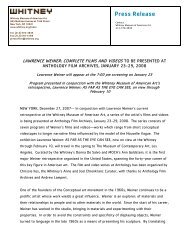Press Release - Whitney Museum of American Art
Press Release - Whitney Museum of American Art
Press Release - Whitney Museum of American Art
You also want an ePaper? Increase the reach of your titles
YUMPU automatically turns print PDFs into web optimized ePapers that Google loves.
Until a decade ago, only forty <strong>of</strong> her films were known to exist; today, some 130 works<br />
have been identified in archives internationally. The recovery <strong>of</strong> Alice Guy Blaché’s work—<br />
both its identification as hers and its conservation and restoration—has involved an<br />
enormous worldwide undertaking by film historians, archivists, and preservationists.<br />
Joan Simon, the <strong>Whitney</strong>’s curator-at-large and organizer <strong>of</strong> the exhibition, notes: “Alice<br />
Guy Blaché—cinema’s first woman director, screenwriter, producer, businesswoman, and<br />
studio owner—is unique in film history. This exhibition introduces new audiences to a littleknown<br />
but historically key figure who had decade-long careers in France and the US, and<br />
affords film scholars a ‘critical mass’ <strong>of</strong> Blaché’s body <strong>of</strong> work by which to place her films<br />
within the international context <strong>of</strong> early cinema. Her films are important examples <strong>of</strong> film’s<br />
evolution as popular entertainment: they are bold, her stories fascinating, her point <strong>of</strong> view<br />
singular, her comedies raucous, and her characters (especially her women and child heroes)<br />
complex. Her career is worthy <strong>of</strong> renewed investigation and she deserves recognition as a<br />
pioneer <strong>of</strong> early cinema.”<br />
Born in Paris in 1873, and raised in Switzerland, Chile, and France, Alice Guy, as she then<br />
was known, studied the new “sciences” <strong>of</strong> typewriting and stenography, and began working<br />
as secretary to Léon Gaumont in 1894 at Le comptoir général de photographie, a<br />
manufacturer <strong>of</strong> still cameras and other optical equipment. This was the corporate<br />
predecessor <strong>of</strong> L. Gaumont & Cie, established in 1895, soon to become one <strong>of</strong> the world’s<br />
leading film companies and today the oldest in continuous operation. Guy learned the<br />
photography business through correspondence, familiarizing herself with clients, marketing,<br />
and the company’s stock <strong>of</strong> cameras, and became acquainted with the new technologies<br />
being invented for shooting and exhibiting motion pictures.<br />
Inventors Gaumont and the Lumière Brothers were friends as well as competitors; both were<br />
trying to solve the problem <strong>of</strong> projecting film. Alice Guy and Léon Gaumont were among the<br />
audience at a private screening in March 1895, when the Lumières presented their<br />
projection <strong>of</strong> a film <strong>of</strong> workers leaving a factory.<br />
Until this time at Gaumont, filmmaking had been in the service <strong>of</strong> science or used as a<br />
promotional tool for selling cameras. “In the beginning, everyone was always shooting<br />
street scenes, parades, or moving trains, which I did not find terribly interesting,” Guy later<br />
recalled. “So one day I said to Monsieur Gaumont: ‘It seems to me we could do something<br />
better.’” Perhaps with the courage <strong>of</strong> youth, Guy asked Gaumont if she could try making a<br />
film that would tell a story. He said yes. Thus, Alice Guy became Gaumont’s first director<br />
(although the term did not yet exist) and soon became head <strong>of</strong> production, spending the<br />
next decade making films at Gaumont’s studios in Paris and elsewhere in Europe, between<br />
1896 and 1907.<br />
Guy’s earliest films at Gaumont share certain subjects and visions with some <strong>of</strong> her<br />
colleagues, such as the Lumières. As Joan Simon writes in her catalogue essay, “The magical<br />
antics when body parts come undone from a body, as in Guy’s Chirurgie fin de siècle (Fin de<br />
Siècle Surgery, 1900), are in the spirit <strong>of</strong> Méliès’s famous and numerous deconstructions.<br />
She also, like many <strong>of</strong> her contemporaries, made travel films and dance films, sometimes the<br />
two genres conveyed in one moving picture, such as her dances filmed in Spain, particularly<br />
the beautiful hand-tinted films Le Bolero (1905), performed by Miss Saharet, and Tango<br />
(1905).”
















